What drives Diana Buist to study breast cancer screening?
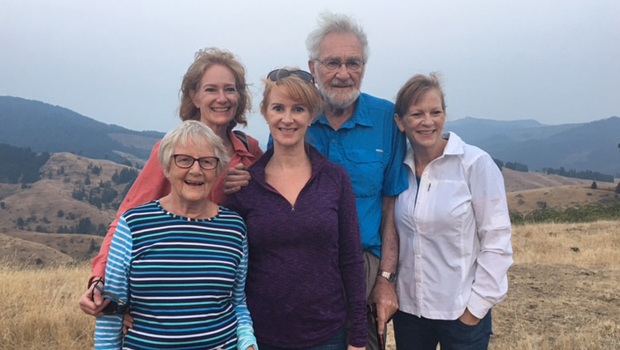
Dr. Diana Buist (R) hiking in Central Oregon with her mother, father, and sisters—Drs. Sonia, Catriona, Alison, and Neil Buist (L-R)—all of whom helped inspire her passion for public health.
Kaiser Permanente Share profiles longtime KPWHRI investigator and director of research and strategic partnerships.
Diana S.M. Buist, PhD, is a senior investigator and director of research and strategic partnerships at Kaiser Permanente Washington Health Research Institute—and an Affiliate Professor in the Departments of Epidemiology and Health Services at the University of Washington (UW) School of Public Health and an Affiliate Member of the Fred Hutchinson Cancer Research Center.
What motivated you to study breast cancer screening?
My whole family on both sides has been devoted to public service: doctors, teachers, ministers, policemen, etc. I trained in public health as an epidemiologist so I could be of use: gathering evidence needed to help people lead healthier lives.
I joined Kaiser Permanente Washington Health Research Institute (KPWHRI, then called Group Health Center for Health Studies) in 1996. I earned my doctorate at the UW while working full-time as a research associate in KPWHRI’s women’s health group.
I focused on studying breast cancer screening largely because many people who I know and love have been affected by the disease, starting with the mother of a close childhood friend. Since breast cancer touches everyone, understanding its epidemiology made it feasible for me to be helpful to a lot of people. I want to help women to get a better sense of their risk as individuals—and to put their risk in perspective and try not to be too afraid of it.
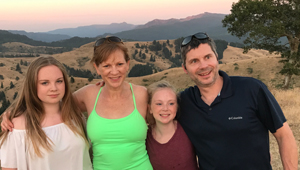
Dr. Buist hiking in Central Oregon with her daughters
Bryn and Abby and husband Ky Haverkamp, PA-C,
a physician assistant at Kaiser Permanente in
Washington who met Dr. Buist when he was an
interventionist at the research institute.
Why is this a good place to research on breast cancer?
In the 1980s Group Health had become the first health care organization to adopt risk-based, personalized screening for breast cancer. In 1994 it became one of the initial 7 sites in the Breast Cancer Surveillance Consortium (BCSC). A National Cancer Institute-funded collaborative network of 6 mammography registries, the BCSC is the nation's largest and most comprehensive collection of breast cancer surveillance and outcomes information. In 2003, I became the leader of the BCSC’s registry here.
With collaboration comes better ideas and more patients, letting us be more precise and have more confidence in our results. Over the years, through our collaboration with the other BCSC sites, we’ve learned so much about the benefits and potential harms of breast cancer screening, which has influenced national screening guidelines. We’ve developed risk calculators for women and health care providers to better understand their individual risk. We’re driven by wanting to educate women about their risk—and about how they can work with their health care providers to decide on the best screening schedule for them based on their level of risk for the disease. Just one example: We’ve learned more about how having dense breasts can make it more difficult for radiologists to see cancer on a mammogram, since both tumors and dense breast tissue look white.
What are the other ways that your work has evolved through the years?
I came here—hands down—for the unparalleled access to rich data from the continuous care of a large population of people. But I’ve stayed for the chance to design and conduct pragmatic trials, with input from varied stakeholders, to help transform health and health care for our patients here and across the nation.
Working with BCSC colleagues in academic medicine, we realized that they need to learn what’s special about conducting research in learning health systems (LHSs) like ours, where care and coverage are integrated and where care and research inform each other to improve health outcomes. And that’s not taught in any formal training program. That was a big part of the Cancer Research Network Scholars Program, which I led for 5 years, helping junior investigators from around the country to conduct population-based multi-site and multi-disciplinary trials.
Now I am taking that a few steps further with Dr. Paula Lozano, leading the new CATALyST K12 Scholar Program. We’re working with colleagues at the UW, Washington State University, and Veterans Affairs Puget Sound Health Care System to train junior scientists in how to do translational research in LHSs like ours. Translation means taking discoveries that are developed in academic settings, and figuring out how to implement them to help people stay healthy. The Agency for Healthcare Research and Quality and the Patient-Centered Outcomes Research Institute recently announced that our program will be one of the 11 first-ever LHS Centers of Excellence for the next 5 years. We’re really excited about bringing that training grant here, with the support of Kaiser Permanente in Washington.
It’s exciting for all of us to do work that helps to transform health care and to improve the lives of large populations. But for that to happen, we need to do a better job of spreading the word about our findings—for instance, that every test and treatment has benefits and harms. A seminal moment happened for me in 2009. That’s when the U.S. Preventive Services Task Force issued revised recommendations, based in part on BCSC results, including that screening women aged 40-49 years should include a shared decision-making discussion to inform women about the benefits and harms of screening mammography. There was widespread backlash about this recommendation, in part because of the too-common assumption that more health care (and screening) must be better. This has led me to continue to think about how researchers need to do a better job communicating about research findings outside of academic research articles.
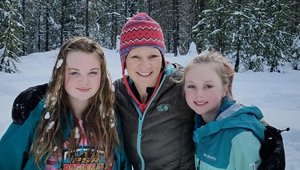
Dr. Buist skiing at Stevens Pass, WA with her daughters
Bryn and Abby.
What else excites you most about your research?
I love collaborating with other people. My colleagues do such a variety of research at the Institute that there’s never a dull moment: We have many chances to collaborate with each other in various configurations. But we can’t do everything here, so I’m passionate about building external partnerships to help us make the discoveries we need to help our patients and providers.
I enjoyed working with teams at other Kaiser Permanente researcher centers, and we were doing that through the Health Care Systems Research Network, even before Kaiser Permanente acquired Group Health.
One of the most innovative examples of strategic partnerships—so far—has been the Mammography Dream Challenge, which we launched with Sage Bionetworks and IBM Research. In this crowdsourced contest, people used KPWA data, artificial intelligence, and deep machine learning to try to improve breast cancer screening at a population level. The problem to be solved is that after screening, 10% of U.S. women are called back for diagnostic testing, with comparable cancer detection to other countries that have 3% to 5% recall rates. Unnecessary harms include cost, anxiety, radiation, and biopsies.
What keeps you going outside of work?
I love hiking, skiing, and traveling with my husband, daughters, sisters, and parents. Both my parents have been long-time physician-researchers at Oregon Health & Science University in Portland. (My mother and father are from the United Kingdom, and that’s why I have two middle initials, U.K. style, instead of just one.)
Our parents’ interests, and what they exposed us to—especially in the developing world—really drives us all. For instance, my mother founded the American Thoracic Society’s international course that trains physicians in emerging countries on how to do research, and I’ve been teaching with her for that course during my vacations since 1997.
It’s no accident that we all work to improve health outcomes. We have a dream that we’ll write an article together with the citation “Buist, Buist, Buist, Buist, and Buist.”
healthy findings blog

What to expect after a screening breast MRI vs. mammography alone
Diana Buist and BCSC find screening MRI leads to more biopsies, finding fewer cancers, regardless of personal history of breast cancer: JAMA Internal Medicine.
Read it in Healthy Findings.
k12 scholar program
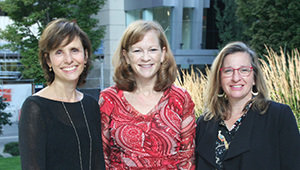
CATALyST K12 Scholar Program: A spark for future LHS researchers
Drs. Diana Buist and Paula Lozano are leading a statewide collaboration to train the learning health system researchers of the future.
Read it in News and Events.
recent News
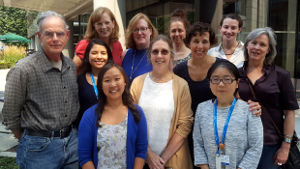
KPWHRI shares in $17 million grant to improve breast screening
National Cancer Institute support continues nation's largest collection of breast imaging data and funds three studies to personalize screening.
Read it in News and Events.
Learning Health System
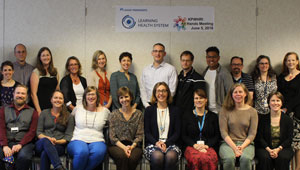
How the LHS Program helps us be best at getting better
One year in, leaders of Kaiser Permanente Washington’s Learning Health System Program describe how research-care delivery partnerships drive continuous learning.
Read it in Healthy Findings.


